

Nng User Experience 2004 in Amsterdam - mprove.de. Abstract Good designers already know how to make products attractive (visceral design) and how to appeal to self- and brand-image (reflective design).
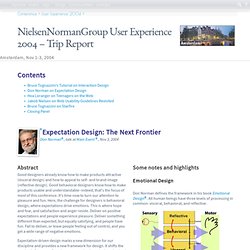
Good behavioral designers know how to make products usable and understandable–indeed, that's the focus of most of this conference. It's time now to turn our attention to pleasure and fun. Here, the challenge for designers is behavioral design, where expectations drive emotions. This is where hope and fear, and satisfaction and anger reside. Expectation-driven design marks a new dimension for our discipline and provides a new framework for design. Some notes and highlights Emotional Design Don Norman defines the framework in his book Emotional Design. UX Apprentice. Research Adam hired me to design his iPad application.
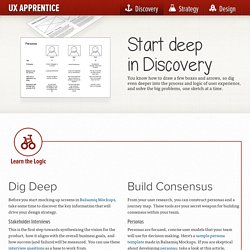
Upload/ux-design-for-startups-marcin-treder.pdf. Toolkit. Reframing “UX Design” I was asked to speak at UX Week 2012, and figured I’d turn my blog post “User experience is strategy, not design” into a talk, but a funny thing happened along the way.

I realized that, yes, UX is design, but not design as we’ve been thinking of it. And by reframing “UX design” as a profession, we can set it up to uniquely address increasingly prevalent business needs. Before tackling the profession, we need to agree on just what “UX design” is. I have not come across a better definition than Jesse’s, which he originally shared in 2009: Hello Erik - User Experience @Erik_UX. “UX is the intangible design of a strategy that brings us to a solution.”
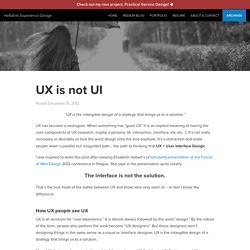
UX has become a neologism. When something has “good UX” it is an implied meaning of having the core components of UX (research, maybe a persona, IA, interaction, interface, etc etc…). It’s not really necessary or desirable to tack the word design onto the end anymore. It’s a distraction and leads people down a parallel but misguided path… the path to thinking that UX = User Interface Design. I was inspired to write this post after viewing Elisabeth Hubert’s (@lishubert) presentation at the Future of Web Design 2012 conference in Prague. The interface is not the solution. The Difference Between Information Architecture and UX Design - UX Booth. Information architects form the blueprints of the web Next to explaining what I do for a living, the second question I most frequently hear is: “What’s the difference between Information Architecture and User Experience?”
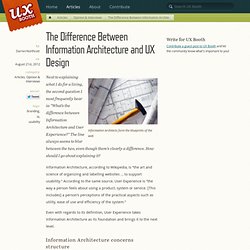
The line always seems to blur between the two, even though there’s clearly a difference. How should I go about explaining it? Information Architecture, according to Wikipedia, is “the art and science of organizing and labelling websites … to support usability.“ According to the same source, User Experience is “the way a person feels about using a product, system or service. [This includes] a person’s perceptions of the practical aspects such as utility, ease of use and efficiency of the system.”
Fixing A Broken User Experience. Advertisement Unless you’re developing completely new products at a startup, you likely work in an organization that has accumulated years of legacy design and development in its products.
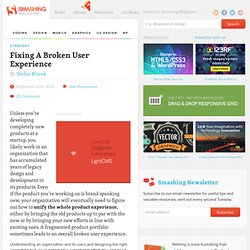
Even if the product you’re working on is brand spanking new, your organization will eventually need to figure out how to unify the whole product experience, either by bringing the old products up to par with the new or by bringing your new efforts in line with existing ones. A fragmented product portfolio sometimes leads to an overall broken user experience. Understanding an organization and its users and designing the right interaction and visual system take exceptional effort. You also need to communicate that system to teams that have already produced work that doesn’t align with it. Lean UX: Getting Out Of The Deliverables Business. Advertisement User experience design for the Web (and its siblings, interaction design, UI design, et al) has traditionally been a deliverables-based practice.
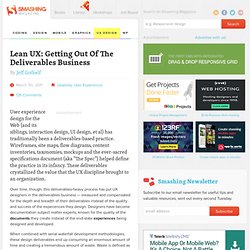
Wireframes, site maps, flow diagrams, content inventories, taxonomies, mockups and the ever-sacred specifications document (aka “The Spec”) helped define the practice in its infancy. These deliverables crystallized the value that the UX discipline brought to an organization. Over time, though, this deliverables-heavy process has put UX designers in the deliverables business — measured and compensated for the depth and breadth of their deliverables instead of the quality and success of the experiences they design. Designers have become documentation subject matter experts, known for the quality of the documents they create instead of the end-state experiences being designed and developed.
Engaging in long drawn-out design cycles risks paralysis by internal indecision as well as missed windows of market opportunity. Enter Lean UX. Lean Strategy for UX Design. Last Fall, we were working on a product for a client whose industry was undergoing substantial disruption.
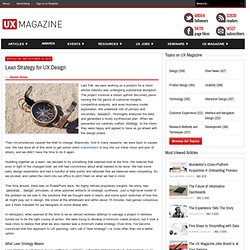
The project involved a robust upfront discovery piece running the full gamut of customer insights, competitive analysis, and even business model exploration. We undertook lots of primary and secondary research, thoroughly analyzed the data, and generated a nicely synthesized plan. When we presented our carefully crafted strategy to the client, they were happy and agreed to have us go ahead with the design phase. Then circumstances caused the brief to change. Massively. Huddling together as a team, we decided to try something that seemed bold at the time. This time around, there was no PowerPoint deck. In retrospect, what seemed at the time to be an almost reckless attempt to salvage a project in distress turned out to be the right course of action.
What Lean Strategy Means What Took So Long? So what took us so long to discover the merits of lean strategy? 1. 2. 3. When Agile and User Experience Click. By Todd Zazelenchuk and Jeff Larson Published: January 21, 2013 “No two software development teams are the same.
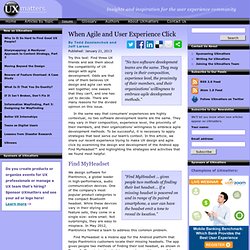
They may vary in their composition, experience level, the proximity of their members, and their organizations’ willingness to embrace agile development methods.” Try this test: Find three UX friends and ask them about the compatibility of UX design with agile development. Odds are that one of them believes UX design and agile can work well together, one swears that they can’t, and one has yet to decide. In the same way that consumers’ experiences are highly contextual, no two software development teams are the same. Find MyHeadset “Find MyHeadset … gives people two methods of finding their lost headset….
We design software for Plantronics, a global leader in high-performance, audio communication devices. Find MyHeadset is a mobile app for the Android platform that helps Plantronics customers locate their missing headsets. Advice Worth Heeding Figure 2—Creating sketches References. UX Archive. Connecting.